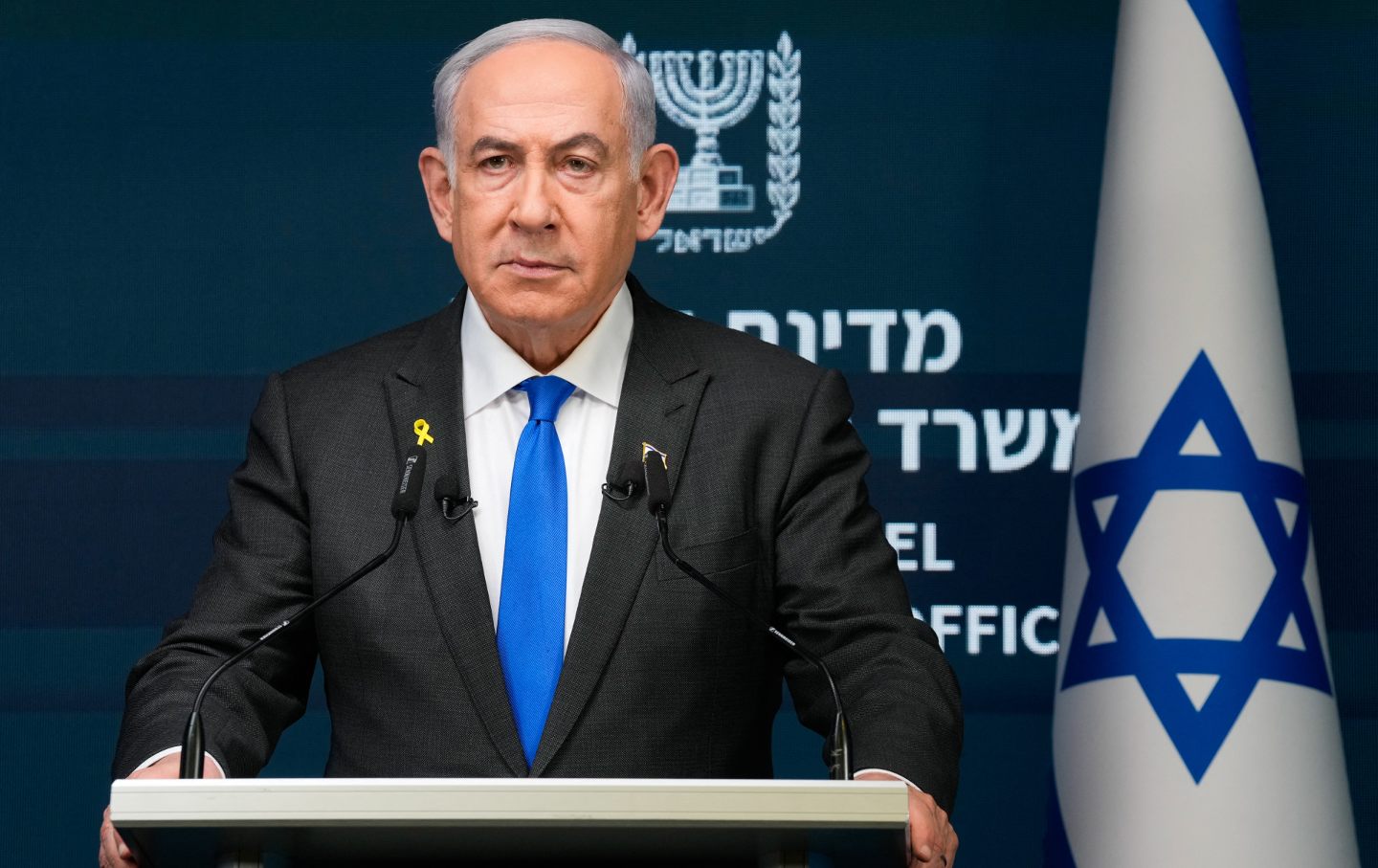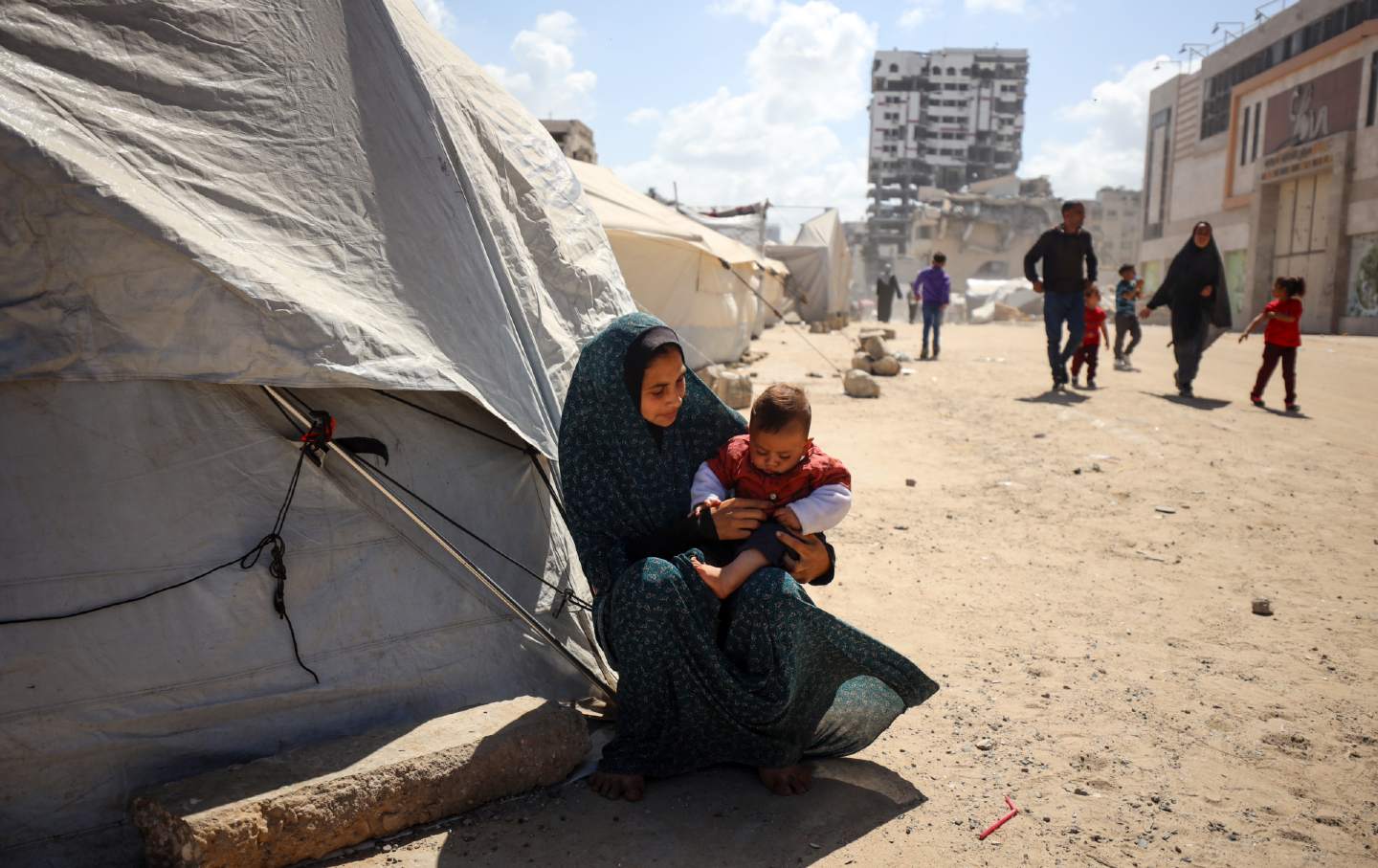There’s Another Way to Hold Netanyahu Accountable for the Gaza Genocide
A case for prosecuting the Israeli prime minister for the crime of persecution.

Every genocide always contains two crimes at once. First and foremost, is the biological crime: the extermination, in whole or in part, of a group of people qua group. Not simply mass murder, but mass murder targeted against a collectivity with the intention of extinguishing a peoples’ ability to constitute a collectivity in the first place. This is what we have come to know as genocide in the legal and colloquial sense.
But alongside each murder, each forced dispossession, a second crime is committed: a cultural one. Libraries are burned, archives destroyed; villages, with their regional and local specificities, their own food and folkways, are razed; historians, musicians, poets, painters are murdered, their memories and their potential murdered with them.
Israel is currently carrying out both of these twin crimes in Gaza. It has murdered an as yet untold number of people (the prominent medical journal The Lancet conservatively estimates that “up to 186,000 or even more deaths could be attributable to the current conflict in Gaza”). And, alongside these murders, it has leveled every university in Gaza, obliterated significant portions of the archives of the Ministry of Endowments and Religious Affairs and the Ministry of Interior (among others), destroyed numerous libraries and publishing houses, destroyed the Great Omari Mosque (built in the fifth century, originally as a Byzantine church), and damaged the Church of St. Porphyrius (built in the 12th century). This is only a partial accounting of the destruction of Gaza’s physical cultural heritage, and there is no possible way to enumerate how many worlds have been lost with the dead.
And yet, within the UN Genocide Convention and the Rome Statute of the International Criminal Court (ICC), the crime of cultural genocide—the idea of cultural genocide, even—is nowhere to be found. Indeed, the constituent acts of the crime of genocide, with one exception, all refer to the physical destruction of the target group. This is despite the initial desire of Raphael Lemkin—the Polish Jewish lawyer who conceived of the crime of genocide, coined the term, and spearheaded its legal codification—to include cultural genocide in the convention. Even though the crime of cultural genocide was excluded from the Genocide Convention, there is a method by which both Netanyahu and Gallant could still be convicted for the cultural aspect of the genocide of the Palestinians—the crime of persecution.
As Lemkin first defined it, the crime of genocide was bifurcated into “barbarism,” or acts of physical or biological destruction, and “vandalism”—the destruction of cultural heritage. On vandalism, Lemkin writes,
An attack targeting a collectivity can also take the form of systematic and organized destruction of the art and cultural heritage in which the unique genius and achievement of a collectivity are revealed in fields of science, arts and literature. The contribution of any particular collectivity to world culture as a whole forms the wealth of all of humanity, even while exhibiting unique characteristics. Thus, the destruction of a work of art of any nation must be regarded as acts of vandalism directed against world culture. The author [of the crime] causes not only the immediate irrevocable losses of the destroyed work as property and as the culture of the collectivity directly concerned (whose unique genius contributed to the creation of this work); it is also all humanity which experiences a loss by this act of vandalism.
While Lemkin’s understanding of the “unique genius” of collectivities has certain essentialist overtones, and his idea of universalism is perhaps either myopically or aspirationally ahistorical and apolitical, the basic idea of vandalism as a first-order crime against the target group itself, rather than merely its property, is forceful nonetheless.
Lemkin’s understanding of genocide as both vandalism and barbarism places them on equal legal footing. Indeed, the Pakistani delegation to the drafting of the genocide convention expressed the view, as summarized by Leora Blisky and Rachel Clagsbrun in the European Journal of International Law, that “not only were physical and cultural genocide intrinsically linked, but cultural genocide was the aim, whereas physical genocide was the means.” Although the Pakistani delegation’s view is perhaps overstated, there is a certain logic to the proposition: What creates a “people” out of a loose group of persons is their shared cultural and historical ties, their daily production of a life in common. If those ties are effectively erased, then the “people” may cease to exist even as the persons continue to live.
Based upon Lemkin’s arguments, the second draft of the Genocide Convention, drawn up by China, France, Lebanon, Poland, the United States, the Soviet Union, and Venezuela included the following definition of what would come to be known as cultural genocide:
In this Convention genocide also means any deliberate act committed with the intent to destroy the language, religion or culture of a national, racial or religious group on grounds of national or racial origin or religious belief such as:
1. Prohibiting the use of the language of the group in daily intercourse or in schools, or the printing and circulation of publications in the language of the group;
2. Destroying, or preventing the use of, libraries, museums, schools, historical monuments, places of worship or other cultural institutions and objects of the groups.
This definition is significantly narrower than Lemkin’s, and narrower still than the first draft by the UN Secretariat, but it was still too much for the General Assembly, which opted to exclude the charge of vandalism altogether. The United States, in particular, was against the provision’s inclusion, arguing that the preservation of culture properly falls under human rights rather than international criminal law. That the US had been engaged in a decades-long cultural genocide of the Native Americans certainly figured into its decision.
Other states, like Sweden and New Zealand, joined in the rejection of the article and more directly attributed their rejection to their colonial motivations and worries about liability for their own cultural genocides.
While the Genocide Convention does not account for cultural genocide, the Rome Statute does criminalize the destruction of cultural heritage—though it classifies it as a war crime, not as an act of genocide. It defines these crimes as “Intentionally directing attacks against buildings dedicated to religion, education, art, science or charitable purposes, historic monuments, hospitals and places where the sick and wounded are collected, provided they are not military objectives” and/or “Extensive destruction and appropriation of property, not justified by military necessity and carried out unlawfully and wantonly.” As is clear from the text, cultural heritage is not protected in every case; there are large loopholes allowing “military necessity” as a mitigating factor.
While the ICC obtained a conviction for the second of these crimes against Ahmad Al Faqi Al Mahdi—a Tuareg-Malian militant who was held responsible for the destruction of nine Sufi shrines and one mosque in Timbuktu—neither Yoav Gallant nor Benjamin Netanyahu, for whom the court has requested arrest warrants, have been charged with this crime.
There remains, however, a somewhat backdoor means by which both men could be convicted for their destruction of cultural heritage—via the crime of persecution, which is classified as a crime against humanity in the Rome Statute (and which has been previously utilized to obtain convictions for cultural heritage destruction by the International Criminal Tribunal for the former Yugoslavia). The crime of persecution is defined as
the intentional and severe deprivation of fundamental rights contrary to international law by reason of the identity of the group or collectivity…on political, racial, national, ethnic, cultural, religious, gender…or other grounds that are universally recognized as impermissible under international law, in connection with any act referred to in this paragraph or any crime within the jurisdiction of the Court.
This crime covers a wide range of activities, including cultural heritage destruction, but it is not clear yet whether the prosecutor intends to utilize the statute in this way. It is important to note that Netanyahu and Gallant are being charged with persecution as a crime against humanity, which does not require the existence of an armed conflict to come into effect. Because crimes against humanity can be committed during “peacetime,” Gallant and Netanyahu can be held responsible for cultural heritage destruction from the beginning of the court’s jurisdiction over the “situation” in Palestine (to use the court’s sterile parlance) in June 2014 (and indeed, Israel has, since the Nakba, and certainly since 2014, been engaged in the looting and destruction of Palestinian cultural heritage in both “peacetime”—which is, for the Palestinians, no peace at all—and during war).
The first element of the crime— the “intentional and severe deprivation of fundamental rights contrary to international law by reason of the identity of the group or collectivity”—is the crucial bit. It means that, in order for cultural heritage destruction to qualify as persecution, there must exist a fundamental right to cultural heritage in international law, and the deprivation of the right must be intentional and severe.
Popular
“swipe left below to view more authors”Swipe →There is significant textual support for cultural heritage as a human rights issue in international instruments and declarations.
The Universal Declaration of Human Rights states: “Everyone, as a member of society…is entitled to realization…of the economic, social and cultural rights indispensable for his dignity and the free development of his personality.… Everyone has the right freely to participate in the cultural life of the community, to enjoy the arts and to share in scientific advancement and its benefits.” The International Covenant on Civil and Political Rights and the International Covenant on Economic Social and Cultural Rights make similar declarations.
While none of these instruments directly reference cultural heritage, the rights they enumerate—the right to enjoy cultural development or to participate in cultural life—depend upon the existence of cultural heritage. Thus, implicit in these treaties is a right to have access to one’s cultural heritage and a corresponding obligation on states to protect such heritage.
There is an important theoretical basis for the right as well. Without a shared cultural heritage, a people is at risk of losing its common bonds and thereby ceasing to exist as a people. This social-reproductive function of cultural heritage places a special political salience on its destruction. Objects, historical or otherwise, are allowed to decay or are destroyed. This is simply the nature of time and of objects.
But the essential political questions for a people are who decides what is allowed to decay or disappear, and how is that decision made. The violence, then, is less a violation of the object than it is of the social order as such. When a monument is destroyed, a grave overturned, an ancient piece of scripture burned, not only is an artifact irrevocably lost, but its cultural heritage also takes on a new signification. No longer does it only signify itself, the people, and their history; it now also signifies the present moment of danger, the present moment of fragility—it signifies its own status as potentially destroyed and, in so doing, it signifies the people’s fragility and insecurity as well.
Seen in this light, there is an additional fundamental right implicated by cultural heritage destruction not covered in the foregoing treaties: the right to self-determination. The right to self-determination, in broad strokes, is the right of a people to “freely determine their political status and freely pursue their economic, social and cultural development.” This right is, in a sense, the ur-right, the right from which other collective rights spring, and thus its implication in cultural heritage destruction lends a degree of urgency and import to that destruction that may be missing from other human rights violations.
This has particular salience to the present genocide of the Palestinians. As Rabea Eghbariah writes in his landmark article “Toward Nakba as a Legal Concept,” “the foundational violence of the 1948 Nakba has not only dispossessed and displaced Palestinians but also fractured Palestinian society and put in place a new regime that is committed to denying Palestinian self-determination in favor of the settler society.” That is, though the Nakba as an ongoing structure overlaps with the crimes of genocide and apartheid, it differs from the two in its end goal: displacement and subsequent replacement, as opposed to extermination without replacement and segregation without extermination, respectively.
Eghbariah continues, “For Palestinians, however, displacement has never entailed a full process of assimilation and emancipation elsewhere, and the Palestinian struggle for their homeland persists.… Displacement has become an indefinite condition of misplacement, one that continues to deny the group their right to self-determination.”
The physical extermination of the Palestinian people is one means of committing the Nakba, but it is also insufficient for Israel’s goal of replacement unless it is also total. So long as there exists a Palestinian national consciousness, there will exist a living testimony to the falsity of Zionist historiography. Zionists, then, must also engage in a cultural genocide–not only the dispersal of the Palestinian people but also the destruction of their material and cultural ties to the land and one another. Not only ethnic cleansing but ethnic erasure: the destruction both of Palestinian people and of Palestinians as a people, a collectivity capable of claiming self-determination. Unlike other genocides, which target a group specifically because they are a people, the Zionist settler-colonial project and genocide are in service of the denial that the Palestinians were ever a people at all.
Seen in this light, the destruction of Palestinian cultural heritage emerges as one of the primary means by which Israel seeks to fulfill genocidal intent. As Mezna Qato recently wrote,
To tell a history of Palestine now often requires seeking access through Israeli state gatekeepers.… Historians of Palestine often note how much harder it is to write a history of Palestine after the Nakba than a history of Palestine before it. A people scattered, isolated, under siege, bombarded, repeatedly massacred and dispossessed, has meant that generations of Palestinians must rely on shards and scraps, a thousand archival retrieval projects everywhere.
Neither Gallant nor Netanyahu can be charged with vandalism (or cultural genocide), despite the overwhelmingly clear match between the charge and their actions, because, thanks in large part to their Western backers, no such charge exists. The prosecutor’s potential usage of the crime of persecution for the destruction of cultural heritage would, however, give expression, however diluted, to the severity of this destruction and its place within the decades-long genocide of the Palestinian people.








